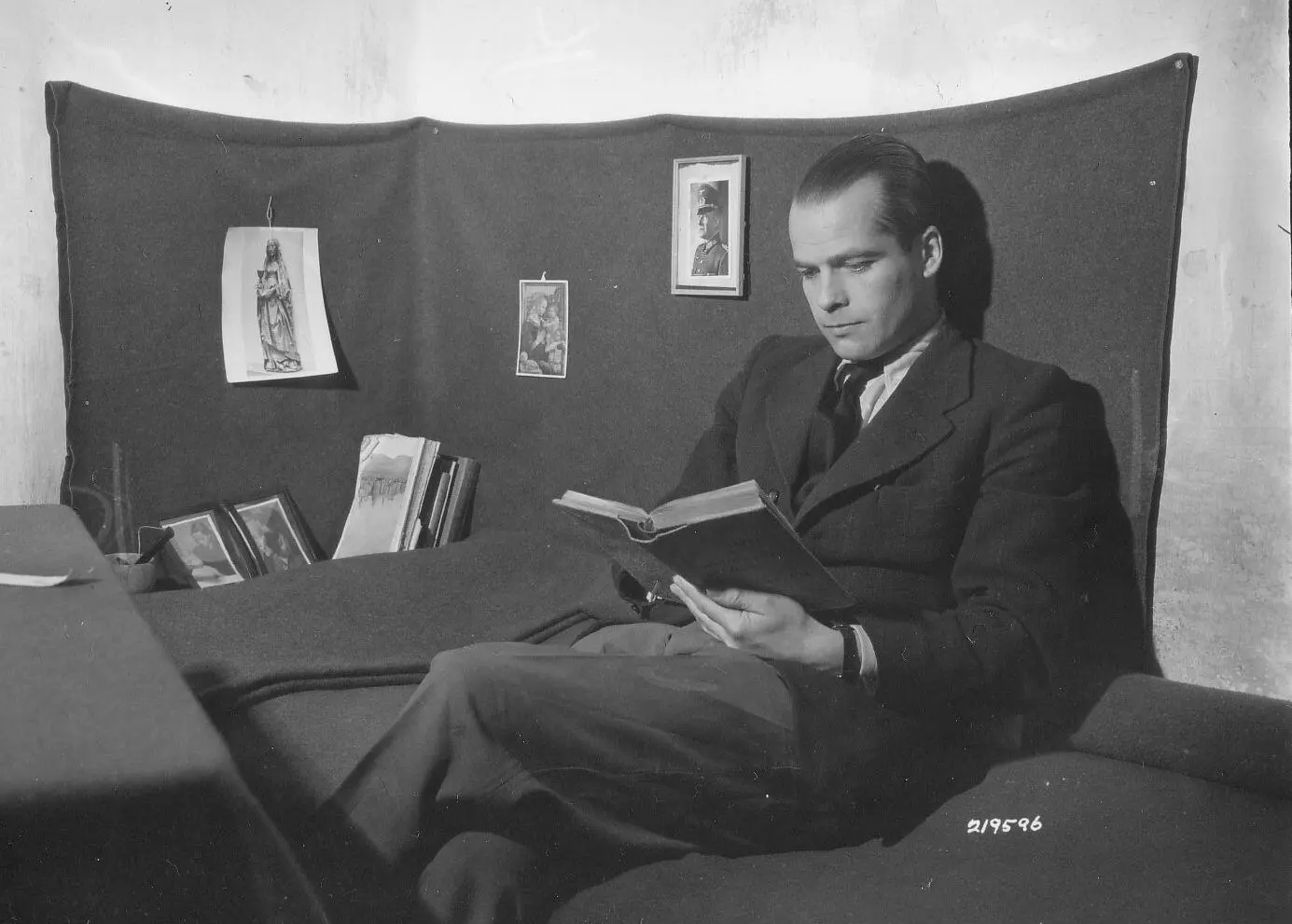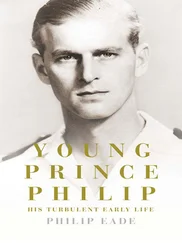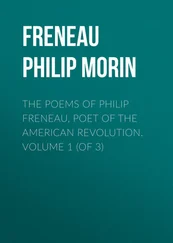Brauchitsch’s importance to Białowieźa was his role as an intermediary forwarding Göring’s orders to the battalion(s) and in return collating their regular reports. Galland offered his allied interrogators an abrasive opinion of Brauchitsch. On 16 May 1945 he said:
Brauchitsch has been with him [Göring] for four or five years and he had a very bad influence, in that he always concerned himself with politics and didn’t hold himself aloof; as a chief ‘Adjutant’ he should have—the varying information should be condensed, but not selected. 54

Image 5: Bernd von Brauchitsch in his cell in Nuremberg prison 1946.
Source: NARA, Hoffmann Collection.
Setting aside Galland’s dislike of Brauchitsch, the evaluation that he was inclined to side with decisions and sift reports was not unusual in Göring’s world. Galland of course was an integral member of the same command structure and his reputation was never really tested over his influence on shaping the fighter command. However, what can be drawn from the observations by the senior echelons of the Luftwaffe was the absence of ‘band of brothers’ style fraternity.
The RFA/Luftwaffe rganization documentation highlights an intensive period of planning around 1935–7 and subsequent annual updates. Evidence of this rganization planning can be found in other scholarship. 55From 1935 apprentice foresters and gamekeepers were required to serve for one year in the army (later the Luftwaffe) before becoming foresters. Older candidates were expected to participate in a three-month military refresher course alongside other Nazi officials. 56Michael Imort has argued this, ‘was all it took to rganization the forest service.’ The Luftwaffe’s rganization and peacetime expansion was based upon a general rganization calendar drawn up by the RFA in the mid-1930s and continually updated to 1940. 57Göring was determined to set in motion plans for the rganization of the Reichsforstbeamte (RFA’s public servants) including all members of the hunt offices to the Luftwaffe. This process behind a rganization calendar issued precise instructions for the transfer of all forestry officials to the Luftwaffe command structure. In 1936 forestry manpower numbered 870,000, and even by 1945 although greatly depleted forestry could still supply conscripts under the general Wehrmacht reserve assessment. 58The RFA’s rganization in the event of war was bound to the Wehrwirtschaftstab (economic warfare staff) of the Luftwaffe with wood and timber both regarded as strategic raw materials. During the war, forestry manpower was rganizat through the Luftwaffe although foresters served in specialist forestry units of the army, navy and Waffen-SS. 59Further evidence of rganizationn rganizationn can be found in the blue-grey uniforms with green insignia that recognised foresters serving in the Luftwaffe. 60From very early on the Luftwaffe was imbued with National Socialist spirit and by August 1944 it numbered between 2.8 and 5 million men, women and youths depending upon on which authority. The largest number of troops were in the ground forces and, in terms of manpower alone, the Luftwaffe constitutes a significant historical entity. 61
In meeting Hitler’s expectations, the Luftwaffe departed from the traditional military formation, incorporating the dogma behind ideological warriors. The roots of this rganizationn began in 1929 when Göring informed the Reichstag of the inevitability of a future German air force. 62Once in power, Göring’s first priority was to consolidate political power. As Minister-President of Prussia, Göring ordered the raising of reserve police and volunteer paramilitary units. They combined his military expertise, with paramilitary policing methods, in security actions to crush left-wing political parties and communists. The police flying squad (Polizeiabteilung z.b.v. Wecke), named after its commander was mustered on 23 February 1933, with a force of 14 officers and 400 men. This formation was garrisoned in the Friesenkaserne, in Berlin, and became ‘godfather’ to the first SS detachments sealing that special relationship between the SS, police, and the Luftwaffe. 63Wecke’s first police actions were on 2 March 1933, rounding up communists and Marxists in Berlin. In 1936 this unit was turned into Prussian police regiment General Göring and was then transferred to the Luftwaffe to form a bodyguard. By 1944, this bodyguard had transformed from a regiment to the panzer division Hermann Göring, and by the war’s end was designated an airborne-panzer-corps. 64
The social appeal of Luftwaffe recruitment was the proximity to advanced technology, aviation and the sense of speed. Compared to the SS, the Luftwaffe represented a larger and more interesting option for the nobility deeply bound by its class, its racism and elitism. Under Göring’s leadership flying, hunting and highbrow rganizatio offered an extension of the prestige, privilege and stimulus they were socially accustomed to. The list of nobles that joined the Luftwaffe included: Philipp Landgrave of Hesse (Nazi party member 1930), Nikolaus von Below (Hitler’s Luftwaffe adjutant), Günther Freiher von Maltzhahn (fighter ace and senior officer), Wolfram Freiher von Richthofen (cousin of Manfred, senior field commander), Heinrich Prinz zu Sayn-Wittgenstein and Egmont Prinz zur Lippe-Weissenfeld (both night fighter aces) and Hans Graf von Sponeck (airborne forces commander). However, like the German hunt, the majority of would-be flyers hailed from the middle-class with strong social values that were based upon professionalism, technocracy and innovation. Even working-class boys saw advantages of technical training and apprenticeship that offered greater opportunities for career advancement.
The proximity to the hunt did not appeal to all flyers. There was a significant group of flyers who rejected the hunt from their entrenched National Socialist ideology. The leading exponent of this group was Hans-Ulrich Rudel. He was a highly decorated flyer who rejected the hunt as a true disciple of Hitler, but was also a guardian of his social class. Göring’s different treatment of Rudel and Galland was influenced by social backgrounds. Both men went to great pains to explain their social backgrounds in their memoirs. Rudel was individualistic, the son of a Lutheran pastor, drank milk, didn’t smoke and spent most of his free time enjoying sports (athletics and skiing). 65Galland’s father was the bailiff of Graf von Westerholt’s estate; a position held by generations and a Huguenot family that left France in 1742. From the age of seven, Galland’s father taught him to shoot and hunt. He was encouraged to fly gliders and enter for the Lufthansa entrance examination. 66Rudel had to wait until he joined the Luftwaffe before he learned to fly. Rudel’s meetings with ‘the chief’ (Göring) were uncomfortable and brief in comparison with his meetings with Hitler. Rudel was the Führer’s favourite and similar characters. Galland recalled hunting a stag in Rominten—a gift bestowed by Göring, ‘it was really a royal beast, the stag of a lifetime.’ 67Recently discovered films show Galland at ease in meetings and during meals in the relaxed atmosphere of Göring’s headquarters. 68During a visit to one of Göring’s castles, Rudel came face-to-face with the Reichsmarschall ‘rigged out in German hunting costume and shooting with a bow and arrow.’ 69This was a counter-narrative about the ‘other’ Luftwaffe as a Nazi rganization that embraced polycratic persuasions. 70Rudel’s ideas came close to the blood and soil rhetoric of the SS and their 1936, claim to be an anti-Bolshevik combat rganization. 71In this regard, the SS and the Luftwaffe were both sides of the same coin. SS zealotry was drawn from pagan myths of blood and soil, while the Luftwaffe drew on the mystery of the forest and the skies. Both Rudel and Galland remained blindly obedient to Hitler.
Читать дальше













